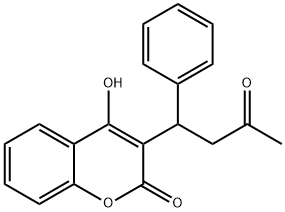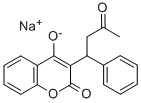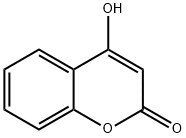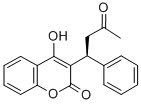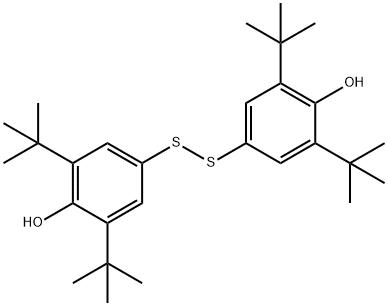A1400350
Warfarin , ≥98% , 81-81-2
Synonym(s):
4-Hydroxy-3-(3-oxo-1-phenylbutyl)coumarin;Coumafene
CAS NO.:81-81-2
Empirical Formula: C19H16O4
Molecular Weight: 308.33
MDL number: MFCD00006854
EINECS: 201-377-6
Update time: 2022-07-08
PRODUCT Properties
| Melting point: | 162-164 °C(lit.) |
| Boiling point: | 356°C |
| Density | 1.1411 (rough estimate) |
| vapor pressure | 0.09 at 22 °C (NIOSH, 1997) |
| refractive index | 1.4434 (estimate) |
| Flash point: | 2℃ |
| storage temp. | 2-8°C |
| solubility | Soluble in benzene, 1,4-dioxane (Weast, 1986), and acetone (Sax and Lewis, 1987). Moderately
soluble in methanol, ethanol, isopropanol, and some oils (Windholz et al., 1983). Also soluble in
toluene. |
| form | Crystalline |
| pka | pKa 4.90±0.01(H2O
t = 25±0.5
I = 0.15 (KCl))(Approximate) |
| color | Colorless |
| Odor | odorless |
| Water Solubility | Practically insoluble |
| Merck | 13,10097 |
| BRN | 8868198 |
| Exposure limits | NIOSH REL: TWA 0.1 mg/m3, IDLH 100 mg/m3; OSHA PEL: 0.1
mg/m3; ACGIH TLV: TWA 0.1 mg/m3. |
| LogP | 2.600 |
| CAS DataBase Reference | 81-81-2(CAS DataBase Reference) |
| NIST Chemistry Reference | 3-(Alpha-acetonylbenzyl)-4-hydroxycoumarin(81-81-2) |
| EPA Substance Registry System | Warfarin (81-81-2) |
Description and Uses
Warfarin was the first of the synthetic anticoagulant rodenticides with structural features inspired by a natural product (88). This prototype coumarin derivative was developed in the 1940s by systematically altering the structure of dicumarol (46), recognized earlier as the causative agent of the sweet clover disease causing severe bleeding in grazing cattle (89). These rodenticides act by inhibiting the oxidoreductive recycling of vitamin K, a cofactor necessary for prothrombin synthesis involved in blood coagulation.
Pesticide and rodenticide
Safety
| Symbol(GHS) |    GHS06,GHS08,GHS09 |
| Signal word | Danger |
| Hazard statements | H300+H310+H330-H360D-H372-H411 |
| Precautionary statements | P202-P264-P273-P280-P302+P352+P310-P304+P340+P310 |
| Hazard Codes | T,T+,Xn,F |
| Risk Statements | 61-48/25-52/53-28-21-36-20/21/22-11 |
| Safety Statements | 53-45-61-52-36/37-28-26-16 |
| RIDADR | UN 2811 6.1/PG 1 |
| OEB | D |
| OEL | TWA: 0.1 mg/m3 |
| WGK Germany | 3 |
| RTECS | GN4550000 |
| HazardClass | 6.1(a) |
| PackingGroup | I |
| HS Code | 29322090 |
| Hazardous Substances Data | 81-81-2(Hazardous Substances Data) |
| Toxicity | EC50 (24-hour) for Daphnia magna 88.8 mg/L (Lilius et al., 1995); acute oral LD50 for rats 186 mg/kg (Hartley and Kidd, 1987), 3 mg/kg (RTECS, 1985) |
| IDLA | 100 mg/m3 |
| Excepted Quantities | Max Inner Pack (1g or 1ml) and Max Outer Pack (300g or 300ml) |

